For the first time Janus photographer Vic Barnes lifts the lid on his eighteen extraordinary years working for the magazine between 1982 and 2000.
Interview by Jon Rayworth
Jon Rayworth: Thank you for agreeing to do this interview Vic. I’ve been looking forward to meeting you. Perhaps we could start by talking about how you got into photography and your background?
Vic Barnes: I was in the RAF for 12 years and the only hobby I had in those days was music and I’d bought one of the very first tape recorders, a great big heavy thing that weighed 48lbs. I was based in Turnhouse in Edinburgh and I came home to Norfolk where I lived with this tape recorder because I couldn’t carry it abroad, the weight of the thing was just horrendous. I didn’t have any other hobbies except music. My father suggested I use the family box camera to take some pictures and I thought, why not and I did and I was hooked. That’s how it started.
JR: How did this hobby become a profession?
VB: I got posted to Bahrain where I spent 9 months, then 15 months in Aden, which is Yemen now and they were places where a brand new Nikon will cost you about £20. I bought a Nikon S3, which is a bit like the old German Contax cameras. I learnt photography through buying a decent camera. I had my first picture published in the [Persian] Gulf News. It was of a Boeing 707, which had just been built, and one of its first stops for unknown reasons was Bahrain. I took a picture of it landing and I sold it to the local press.
JR: Do you remember when that was?
VB: It would be about 1960. That was it from that point I really never looked back. I got a taste for it and buoyed by the fact that I’d had one of my pictures published, I thought I must be quite a good photographer. One of the first big jobs I had after I turned pro at the end of 1969 was a rally for BMW. I’ve always had an association with BMW ever since I started. I was their official UK photographer for years. I actually ended my career still working for them. I’d gone from photographer to writer over 30 years with BMW and not many people can say that.
JR: So how did you come to work for Janus?
VB: I was between photo agencies. I worked in Fleet Street in 1980 and the guy who ran the photo agency I’d been with had retired. Somebody said to me Janus were looking for a photographer but I thought it wasn’t really my scene. I knew what Janus was, don’t get me wrong, but I wasn’t into the subject. I also knew they paid quite well and were a good, straightforward, honest company, so I decided to go along and see. I phoned up and spoke to Peter.
JR: And this is Peter, the Editor of Janus that we’re talking about of course. What were your first impressions of Peter?
VB: I didn’t really have any until after we’d done the interview. Peter invited me to come along and meet him. He said to me, ‘I’m looking for a photographer, I don’t know what I’m looking for until I find it,’ which I thought was a great way of expressing things. He looked at my portfolio, which was all motor cycles and page 3 style pictures of girls. He said, ‘You’re a good photographer but I’m looking to do something a bit different in Janus, do you think you can handle it?’ He explained everything and I said, ‘Yes, I’ll give it a go.’ The first shoot we did was the shoplifter from Janus 15 I think (below). She took that punishment for real.
JR: Yes, she was certainly a model who was into the subject.
VB: She was. She was also doing nude modelling and all I remember her saying was, ‘You can hit me as hard as you like’. I said, ‘Really?’ She said, ‘Oh, yes, I quite like it’. She said, ‘I’ll tell you if it gets too much but you can do it really hard if you like’. I was amazed when I saw how much she could take.
JR: From our earlier conversations I remember you saying that one of the first photo shoots you did was of Michelle from Janus 14 (below).
VB: That front cover of Janus 14, I remember Peter going absolutely ga-ga over that picture.
JR: In this magazine there are about 7 or 8 pages of Michelle just waiting for her punishment. Where did the inspiration for that come from?
VB: Well I was just learning at this point. The idea was Peter’s. He was imparting information to me at a phenomenal rate. I was trying to soak it all up to understand what we were photographing. When I got a grip of it Peter then used to leave it to me in the most part. As far as photography was concerned he didn’t have a clue what looked right and what didn’t, so I would then be charged with finding a shooting angle on something. It became very much a 50/50 relationship, when it came to putting the photo fantasy together. We called it photo fantasy because we didn’t want anyone to think it was real. We wanted people to look upon the pictures as a story in themselves. They could read the text, look at the pictures or do both. We hoped people would first of all look at the pictures and then go back and read the story.
JR: So in a sense you were providing readers with the opportunity to experience the photo fantasy in several different ways?
VB: As time went on we got better and better, especially listening to feedback from the readers. Incidentally 99% of the readers’ letters in Janus were real. Peter and I created the odd one or two to generate feedback. There are not many adult magazines that could say that.
JR: You had an amazing postbag in those early days because people were responding so well to the work you and Peter were producing. I suspect that most readers would be surprised to discover that you didn’t have an interest in the subject matter and that it was through Peter’s eyes that you learnt what to look for.
VB: It may not have been my subject but Peter was educating me and I’m not minimising it but he knew the subject inside out and upside down and round the corner. I didn’t know anything about it when we started but I did learn very quickly. Once I knew what the storyline was I was able to learn a lot of the nuances from Peter.
JR: What were the nuances that you learnt to look for?
VB: It was really facial expressions more than anything else, body language was very important too. You’ve got Janus 14 open at the moment. The picture on the front cover of the girl in a schoolgirl’s outfit really does capture what Peter wanted. The girl standing outside the Headmaster’s study, not quite sure whether her skirt is too short, whether she’ll look like a scruff bag when she goes in, what sort of punishment she’s going to get this time…
JR: It’s a wonderfully evocative front cover. So many of your covers were.
VB: Well, thank you. Body language and the expressions are so important. The idea behind the story was quite often just a little bit over the top but Janus readers seemed to like that. Being part of it through those early stages where I was learning the subject I could understand why people were into it and to a certain extent I could empathise with them. I don’t think I could have done Janus unless I’d had that empathy for the subject.
JR: I’m guessing it was that empathy for the subject that meant you were also pretty handy at writing fiction for the magazine. You wrote a number of short stories didn’t you?
VB: Yes, Nicholas Holland was me! I wrote the Victoria Moon stories (Janus 25 and 41). Peter used to like me writing because he said, ‘Your writing is very gentle and there’s room for that in Janus, you must write more’. I told him, ‘I haven’t got the bloody time Peter!’
JR: You mentioned when we spoke before that creating each issue was very much a labour of love for you and Peter. What was the working process like?
VB: Bear in mind that at that time you couldn’t use a computer to plan your magazine, you had to use the old fashioned way of doing it which was pasting up pages, putting in text that a type setter had done for you in the font and everything that you wanted. So we had a guy doing that who was actually a contact of mine, I got him to do it because he was a graphic artist. Like me he specialised in the motorcycling industry. He said to me one day, ‘Vic, I’m not blaming you because you and Peter know what you want but the trouble is I’m getting 50% of it wrong every issue.’ ‘I don’t know this subject and I think you should do the layout.’ So I ended up doing it but he still pasted the boards. I developed a system where I ruled up a page with the columns and everything and then photocopied it millions of times. I took one of these for each page of the magazine and worked out the crop with a china graph on the 10x8s that I’d printed.
JR: So that’s mostly your china graph writing on the 10×8 prints that we’ve got in the archive then?
VB: Yes, all those china graph marks are mine. I really was the photo editor; Peter just let me get on with it. That was fine by me as I had my own ideas by that time and I knew the way Janus was. So I did the layouts from probably about my fourth or fifth issue and I did them every issue after that. We had a philosophy with the layout and with the front cover. We didn’t change the front cover because we wanted it to look dated. So the way the magazine was laid out, there were no flashy bleeds or anything like that. It was done very sequentially so people could read the pictures like they would read text. It was always difficult to sync the pictures and the text so we didn’t worry too much about that. It was nice if we could. Janus developed this look because we saw it like a flashback to another time.
JR: That’s really interesting. Was it a monthly production cycle at the time?
VB: I think we did very briefly go monthly but by and large it was bi-monthly.
JR: So in terms of the photography side of things did Peter eventually just leave you alone to create the shoot?
VB: He did, but he also liked to come along to the shoots.
JR: Just to oversee things presumably?!
VB: He’d come along and pitch in and sometimes we used to change the story and he would make an observation and say, ‘Look this would be great if we did that again because I’ve got a slightly different idea for the middle.’ ‘Do you mind shooting another version of that?’ He’d let me set it up and shoot it, he never directed me. Even right at the beginning he never directed me. One of Peter’s roles in the shoots we did was, when we were doing close ups of the bottom I’d get him to do the whacking. The fact was Peter liked doing it anyway…
JR: I’m sure he did – one of the perks of his job!
VB: He knew exactly how to do it. He knew exactly what weight to put on the cane and everything. So although Peter might have enjoyed it he was also the best person for the job.
JR: Tell me about ‘the impact shot’?
VB: I invented the impact shot. Nobody had ever done that. I can’t remember the first one we did but it wasn’t an accident. I saw it through the viewfinder, a quite ample bottomed girl hit with the strap. You imagine throwing a small pebble into a big pond and the way the ripples go to the outside, that’s what happens to a bottom when you use a strap or a cane. With a cane you get this scalloped effect, it’s like a tube cut down the middle as it were, just very briefly. It’s difficult to photograph because with a single lens reflex camera there is actually a delay and if you try and time it precisely you’ll miss it. I had to find this out. I was wondering why I wasn’t getting this impact shot. So I started to look very carefully the next time we had a shoot with a girl who was quite happy to take it. We did this one and I looked at it, I didn’t even take a picture, I watched what happened carefully and just briefly I saw that ripple. I realised it came about a quarter of a second or maybe less than that after the actual impact. I was getting the point of impact precisely but you had to wait a quarter of a second before you pressed the button otherwise that ripple effect wouldn’t be there. I learnt to be always a little late but you couldn’t be sure you’d got it until you saw the negatives. If the girl had a skinny bottom it was far more difficult to capture than for a girl with an ample bottom. There was just more flesh to ripple. You didn’t have to hit hard to achieve the effect.
JR: How did you set up an impact shot?
VB: Well I used to say to the model, ‘We’re going to go for an impact shot, you won’t get hurt.’ I never did it until I was sure they could trust me. I’d say, ‘This is what we’re going to do.’ I’d do a count 1, 2, 3 at which point I’d ask Peter, or whoever to hit the model on the bottom so that I could capture the ripples. The only way to do this and get it to look right is for the model to put an expression of pain on their face before they feel the impact and hold it for at least a couple of seconds. If you think about it when you hit someone on the bottom for real the expression of pain doesn’t come until after the ripples have gone. So in a sense impact shots where you can see the model’s face are partly faked pictures. If we wanted marks and the girl was happy to take it lightly or we were lucky enough to find someone who was into it then I could do impact shots. Sometimes the model couldn’t handle it but in my experience women seem to have a much higher pain threshold than men. I reckon about 20% of the girls that modelled for Janus got to enjoy it. I remember talking to a girl a couple of years after she had appeared in the magazine and she said that she had never been spanked before but admitted, ‘I like being spanked.’ I said, ‘Oh, I didn’t realise you were into it’ and she said, ‘I wasn’t, but I am now.’ It’s amazing the number of girls that have said that.
JR: I guess for some people if the shoot is their first experience of CP and they enjoy it, that discovery is likely to be part of their sex life going forward.
VB: It was a sexual turn on for some of the girls. Before Janus I did page 3 stuff and glamour calendars and I always used to ask the girls, ‘How do you get on with this subject?’ ‘Do you like being a sex symbol?’ They would always say they loved it, that they felt empowered by it. So many girls have said that being an object of other people’s sexual fantasies is very enjoyable,
JR: You mentioned Nicola Redway and Priscilla (below) and I was going to ask you what you remembered about them. They were obviously incredibly popular models.
VB: Well the girl who played Nicola, I can’t remember her name now; she was an absolutely lovely person. She wasn’t really into it, although I thought she was a little bit but wouldn’t admit it. She was a delight to work with, some girls just were and it wasn’t always the ones that were heavily into the subject. Nicola understood the subject, she was a very intelligent woman, and she got it in the same way I did, from an intellectual stand point. She was every bit as good as the background we gave her in Janus 68. We told her she’d got her degree but in real life she was an academic girl. She’s one of the standout models of my time on Janus
JR: I think a lot of readers would agree with you! Was she actually a model?
VB: No, not at all. She came to us and it was the only work she did.
JR: I’ve brought some photos with me from what I guess would be termed ‘classic photo fantasies’ and I wonder if these bring back any memories. We’re looking at Michelle from Janus 14 for starters, although I know we’ve already discussed her.
VB: Michelle obviously wasn’t her real name but I really remember her. She was one of the first girls that really could act.
JR: She was in the St Winifred’s Trilogy as well. What was your involvement in that project?
VB: I wasn’t involved that much really – I came in to do some of the stills at the very end of the day. I’d only recently joined Janus and the stills were just taken to promote the videos really.
JR: We’re looking at photos from both of the shoots in Janus 14 and this was the first time that the ‘Janus House’ in Greenwich was used wasn’t it. Can you tell us a bit about this amazing location?
VB: You’ll find it also appeared in the Crossbow motorcycle calendar! My association with Janus brought me into contact with some interesting people. I met a girl who wouldn’t work for Janus but I got on really well with her and she said to me, ‘ I’ve got a location you might like to use.’ ‘It’s not mine, but the bloke I’m going out with now, it’s his mother’s!’ I was desperate for some good locations so she took me there and I met the woman who owned the place. I explained what would be going on and she said, ‘Absolutely no problem!’ She was so open-minded she didn’t give a damn.
JR: It’s a wonderful location and it appears in a number of issues. We’re now looking at photos of ‘The Wedding’ shoot from Janus 16 (below).
VB: I loved that shoot. It was so ridiculous!
JR: Where did you shoot it?
VB: It was done at the Ritz. We hired a suit for the day and I believe Gordon Sergeant ended up staying there over night to make sure Janus got it’s money’s worth. We also did another issue a few years later at the Kensington Hilton
JR: Was that with Nicola?
VB: You’re right, it was. I stayed in the room overnight that time!
JR: We’re now looking at a photo of Serena James in ‘The Treatment’ from Janus 16 (below).
VB: I remember her. I love that expression – brilliant isn’t she?
JR: This was where Janus was really making its mark because you were capturing that anxiety and anticipation before a punishment. Obviously Blushes went on to do this very effectively as well.
VB: Blushes copied us and did a very good job of it. They bought their own particular style to bear on the subject and Blushes turned out to be a pretty good magazine – I thought the written content was poor though. It was basically the same story every week.
JR: I think most people would agree that the photography in Blushes was superb but the magazine didn’t have contributions from the likes of Paula Meadows or some of the excellent writers Janus used. A particularly severe photo story was Janus 19…
VB: Yes, this location belonged to a friend of mine who was in the music world. I did some record covers for him and he got to know what I was doing. He produced a lot of great artists. We became friends through motorcycles of course and he let me use his flat for loads of things.
JR: I think the flat appears again in Janus 21 (below) and you can see all the records on the wall.
VB: Yes, the record producer making his Janus debut as a model. I remember it well!
JR: We’re looking at a still from ‘Schoolgirl Screen test’ in Janus 19 (below), which was also shot in a hotel.
VB: We very rarely put long socks on a model.
JR: In the early days censorship wasn’t really an issue, but it became one didn’t it.
VB: Yes, the turning point came when Westminster Council started to licence sex shops and they gave Janus the first license. But then they started to turn against licensed shops! Janus was the least of their worries. It was well run and it stayed within the law all the time. Prior to the licence it seemed the authorities were happy with Janus – they never caused us any problems. As soon as we were licensed they started raiding the shop once a week! The first time they raided the shop they completely emptied the stockroom. They took all the magazines away and only needed one magistrate that was sympathetic to give them a destruction order and they could burn the lot. That’s justice?
JR: That’s probably the reason that a number of early magazines are really difficult to find now. You and Peter were two parts of the dream team but it’s important to remember Paula Meadows whose contributions as a model and artist were immense.
VB: Oh well Paula was a top class artist.
JR: I always felt Paula’s artwork gave Janus a continuity that other publications lacked. What do you remember about working with Paula?
VB: I knew Paula anyway, only on a casual basis and I got to know her much better when she worked for Janus. I loved her work, even though I’m not into the subject. It was a shame that we couldn’t continue to use her when she started to edit Februs but we found Hardcastle, who was also an excellent illustrator and Paula loved his work too. We had to find someone else of that standard. To a lot of people Paula will always be No1 in the world of CP illustrations and nobody will ever knock her off the top spot but Hardcastle was a good second, and a nice guy.
JR: So the three of you worked well together for a number of years?
VB: Yes. Peter was a steady hand on the tiller. He didn’t ever really tell me what to do, in the same way that I never told him what to do. We trusted totally in each other, which was the beauty of the teamwork we had.
JR: Would you say working with Peter was the closest collaboration of your working life?
VB: Yes.
JR: What was it like when you were working together?
VB: 90% of the time it was great because we totally trusted one another. Peter trusted the fact that I understood the subject and that he couldn’t direct me any more. In fact there were times I’d say to him, ‘This is wrong.’ Nine times out of ten if I criticised anything he did or vice versa that would be OK, but every now and again there was an explosion and you wouldn’t even want to be in the country for ten minutes. Eventually one of us would say, ‘Come on, enough is enough, let’s go over it again, I’ll keep my mouth shut this time until you’ve finished.’ One of us would back down, it didn’t matter which because there was no loss of status or anything like that. If we had an argument and I was at fault eventually I’d say, ‘Alright Peter, lets do it your way, you were right, I jumped the gun.’ If it was the other way round he’d say the same thing. He often said that when we had our arguments, which thankfully were very rare, if Vic doesn’t think the same as I do he must have a point. I said that’s exactly how I think. We always sorted it out.
JR: I think the best working relationships are where people are able to take a step back and think hang on a minute, the other person is seeing this slightly differently, is there something here that I’m missing.
VB: Exactly, that’s how we used to bring the thing to an end. We both knew that it wouldn’t last ten minutes. Ten minutes would be a long time for an argument between Peter and me, but my Christ when we argued. I remember saying to him a couple of times in the early days, ‘I can’t believe you, I really can’t.’ ‘You tell me to do this and when I do it, you don’t like it.’ ‘I can tell you what I see when I look through the camera lens but you don’t look through the lens.’ ‘You don’t know what I’m doing.’
JR: You were both ‘detail’ people weren’t you?
VB: We were. It just worked though. You don’t get relationships like that by accident. The funny thing is we are both Leo’s
JR: How would you describe Peter?
VB: A brilliant writer from the old school. I don’t write like that but Peter said to me, ‘Whatever you do don’t try and copy me.’ I said, ‘It will be very simple Peter, I know my limitations and I’ll work within them’. He said, ‘That’s exactly why you’re a good writer.’ I liked that.
JR: That contrast of styles made for a great combination. Peter used to write most of the photo fantasies didn’t he?
VB: No he didn’t! It was 50/50 again. Sometimes he’d start writing the photo fantasy and ask me to finish it for him because he’d have a lot of sub-editing to do. (He’d often end up re-writing stories for the magazine that had been badly written.) He may have done the first five or six paragraphs but he’d have set the characters up so I’d take it and finish it. We did that a number of times.
JR: So it was a collaboration?
VB: Yes, and not always Peter first and me second. Sometimes Peter would ask me to start it and he’d finish it.
JR: There was one other thing that I wanted to ask about the photography itself because obviously we talked about the impact shot that you created earlier but one of the things I noticed when I was looking at the 8×10 black and white prints is that in some instances, and I’d never picked this up when reading the magazine, you had created a way of putting cane marks on the photo which I would never have known unless I’d actually seen the original prints.
VB: Yes, invariably when magazines have tried to do that in the past it just looked fake. Remember this was Janus – if we’re going to fake anything it’s going to be done properly. We tried all sorts of things to perfect it and used a couple of techniques. There were some photos where you could actually use a china graph pencil and that would work as long as you knew how a tramline was formed. It had to taper at both end and so on and that was one way of doing it. The best way was to use some lipstick on the cane and then press the cane onto the bottom.
JR: As far as the marks you added with the china graph pen are concerned the only way you can tell is if you catch the original photo in the light and you can see the marks on the print. I don’t think anyone would realise otherwise.
VB: The beauty of that method is that you’d never see it in reproduction. When you look at the result in the magazine you wouldn’t know. We didn’t do it that often because if we could get it right on the shoot it was less work for me! I didn’t want to spend all my time in a dark room getting the prints just right – but they had to be right.
JR: Do you remember much about your time working above the shop?
VB: I remember the first time I met Peter. I went up to the little office above the shop and they had a Jewish tailor half way up, we were on the second floor I think and we had a small office and Peter was ruling that little roost. I’ll tell you one thing, you won’t believe this. The door opened one night, no knock, we were both sitting there, it must have been about 6pm and in walked Tina Turner!
JR: She wasn’t there for a Janus photo shoot?!
VB: She’d come to see the Jewish tailor!
JR: What a shame you couldn’t convince her to pose for Janus! That would have been a real coup.
VB: I know! She said, ‘Oh sorry, I’ve obviously come into the wrong place.’ I said, ‘Yes, you have, who are you looking for?’ and she explained. I said, ‘You’re Tina Turner aren’t you?’ She said, ‘Yeah’ but she looked like a scrag-bag, she had her hair all covered up, no make-up on at all. It was when she was recording that first album in England. Being a music freak I immediately recognised her but that’s about the only thing I remember about the period when we had offices above the shop.
JR: We’ve obviously talked a lot about Peter but I wanted to ask you about your working relationship with St John North who took over as editor from Peter.
VB: St John and I, in the end, got on well. I was obviously very sad to see Peter go but I wanted Janus to continue and by now I was steeped in Janus. I wanted it to be as good as when Peter was editor. I knew that if St John listened to me, which he did, then we could do something. We did a few issues together and I enjoyed working with him. Again, he trusted me and I could feel that and he used to ask my advice. I like him a lot. I think he’s a great guy.
JR: You would have first met him when he came in for his staring role with Sophie Fennington in Janus 53. What do you remember about her and that shoot?
VB: Not a lot to be honest. I’m amazed at how much I have forgotten! Especially when you emailed through those pictures. It brought back a few memories but some of the shoots I couldn’t remember at all.
JR: One of the most interesting characters in Janus history, and perhaps the most difficult to pin down was Gordon Sergeant. What involvement did you have with him?
VB: I only ever spoke to him on the phone. I never actually met him in person. I think Peter may have met him once or twice.
JR: Few people ever seem to have met Gordon. I think he was a bit like the banker in ‘Deal or No Deal’!
VB: That’s a very good description of him. Every time we spoke I used to encourage him to come in and see what we were doing but he used to back off. Now and then we’d get a directive signed by Gordon and we’d have to jump to it. I remember Peter telling me about this hilarious conversation he’d once had with him. To put this in context, Gordon was a man of means and quite the philanthropist and he’d had this idea to open a retirement home for elderly spankers! Honestly! He was dead serious about it, he described in detail the uniform that the young, all female staff would have to wear and he was talking about placing an advert in the magazine for potential residents to apply!! We laughed a lot about that. I was so sad to hear he had died – he was a one off.
JR: Absolutely. I wanted to talk a little bit about censorship. In the early days Janus was obviously able to feature ‘schoolgirl’ fantasies and then there came this interpretation of the law that marks couldn’t be shown and certain fantasies were off limits. I wondered what your memories were of that time and how you and Peter dealt with it?
VB: It was really difficult for Janus because we had to stay within the law. We knew the restrictions and we wouldn’t step over the boundary. We did everything we could to push the envelope in terms of creativity and take it to the edge. Peter and I knew exactly how far we could go. We were meticulous with our detail as well. Even when we were doing shoots Peter would say, ‘As much as I’d like to do that Vic, I don’t think we can.’ We had to keep within the law.
JR: I know that you were involved in the production of some of the Janus videos and I believe that ‘The Disciplinarian’ was one that you actually shot?
VB: That’s right. ‘The Disciplinarian’ photographically is not very good. It was the first time I’d ever used a video camera. I hadn’t quite got the balance at that time between the cut away and the various aspects of cinematography that I know now. There are a couple of jump cuts in ‘The Disciplinarian’ that I’m not proud of but we couldn’t get round them. ‘Moral Welfare’ was a lot better, by then I’d started to learn how to use a video camera.
JR: And presumably you shot the stills on both videos as well?
VB: I did yes. They were the only two I was involved in.
JR: ‘The Disciplinarian’ is very notable because of course it was Antonia du Bois’s star performance (below). What are your memories of her?
VB: A lovely girl. Very genuine and very feminine and heavily addicted to the cane! She was very much into the subject.
JR: She’s punished quite severely in the photo shoot and video. Did she request that?
VB: She did, but nobody ever took advantage of Antonia du Bois. Of course the name is a deliberate joke. I can’t remember what her real name was now but it doesn’t matter, as she will forever be Antonia du Bois. She’s an icon isn’t she?
JR: Absolutely. I don’t believe she ever appeared anywhere else.
VB: No she didn’t. She was a Janus fanatic.
JR: What is there to say about the German Director of the Academy, Dr Weltscheim?
VB: He couldn’t remember his lines at all. I had to hold them up on bits of paper for him!
JR: Oh god, he was reading off cue cards was he?
VB: Probably the beginning and the end of his acting career I suspect.
JR: Did you do the Janus 20 photo shoot for Antonia at the same time as the video?
VB: No they were done separately. I think we had to wait for the marks to clear after the photo shoot. I can tell you she went home with a sore bottom on both occasions!
JR: She came back and did a lovely interview a few issues later in Janus 24. Did you take the photos on that occasion as well?
VB: Yes, Peter did the interview. She loved working for Janus. I mean that front cover of Janus 20 is fantastic. A lovely girl, great to work with. Our favourites were like that. Nicola Redway, she was the same, gorgeous girl.
JR: Are there any other Janus girls apart from Nicola and Antonia that stand out for you?
VB: Those two certainly do and of course Natalie (from Janus 132, 133 and 138). Lovely girl, she looks young, behaves young, talks young. I love the front cover of Janus 132 – every expression is perfect…it’s a good front cover.
JR: It’s amazing and it’s got two of the most popular Janus models from later in the run on it.
VB: Look at Hilary (Hanbury-Boyce). Fantastic.
JR: Tell me about Hilary because she came into Janus through you didn’t she?
VB: She was one of my acquisitions. I met her on a shoot – she was a foil for one of the models. She asked me what else I did and I told her I did Janus magazine and she said, ‘If you want a mature model for any reason or an actress just give me a ring I’ll be glad to do it.’ We used her quite a lot and she was great. She’s got this wonderfully stern expression, great profile, but she’s such a gentle soul in real life. I think the little blonde on the cover of Janus 132 looks absolutely stunning!
JR: That’s Tara Duncan in her first appearance in the magazine. She was very popular and returned several times (Janus 139, 155 and 156).
VB: Natalie though – what a naughty little thing! She did quite a lot of porn. You know I see these pictures now and I’m proud of them. I just can’t remember doing some of them. I know I shot them but I just don’t have a memory of some of the individual shoots.
JR: You have every reason to be proud of them Vic. Having taken so many it must be hard to remember individual ones?
VB: I guess after 130 issues with two shoots an issue it’s not surprising!
JR: The magazine maintained a very traditional feel inside but I suspect readers were comfortable with that.
VB: Readers really liked the layout. There was a debate in one issue early on about the front cover and we got so many letters coming in to say ‘Don’t change it, don’t change it’. So we didn’t.
JR: Where did you find most of the models that appeared in Janus?
VB: We advertised in ‘Girl About Town’ and we got a lot of girls applying to model through that. Occasionally I’d bring in a professional model I’d worked with before, who I knew from talking to that she was either slightly into it or she would do it because we paid a normal model rate and she wasn’t going to get ripped off. I used to bring in one or two professional girls who were interested in it. Most of the girls said ‘I’ll do it but you have to be gentle because I’m not into this’ and they may have had another shoot the next day. We always respected this – that’s why so many came back to work for us again because they knew they could trust us. The trust we established with our models was more important than anything else.
JR: Well, lets have a look at some highlights from the early days. We’ve got some of your original 8×10 prints here…
VB: Ah, the lovely Paula – showing her arse!
JR: Working with Paula as a model, what was she like?
VB: She was great. She was already an experienced model so she was very comfortable with it. A very intelligent woman, Paula. You talk to Paula you had a conversation. She was a very good model. She was a very good person.
JR: We’re looking at some photos for Punishment Ballet from Janus 22 (below). Do you remember much about that shoot?
VB: Well the location is in Chiswick; it’s a dance studio. I knew about it but I didn’t know if it was open for hire until I went down there. We went in and bear in mind we were paying between £25 and £40 for a location for the afternoon, which was very cheap they said £35. We told them we would be shooting semi-nude and they said, ‘Don’t worry, we’ll leave you alone.’
JR: You had four models as well, which would have made it a slightly more expensive shoot?
VB: Well, yes, it was. I think when we shot that Janus had already picked up a lot. We weren’t quite there, but we were getting there. I think we got there around the end of the 20s. But I remember that shoot. It was a pleasure to do. None of the girls could dance. We didn’t bloody know either! We just posed them like that and hoped no one would notice.
JR: I think you got away with it. I don’t recall paying that much attention to the actual dancing! Although you used the house in Greenwich a lot at that time almost every magazine seemed to feature a different location. I think it was another feature that set Janus apart from its rivals at the time. Was it easy to find these places?
VB: Well, another secret. There were a lot of aspects of the Greenwich house that were different from each other. Sometimes we were using Greenwich and you wouldn’t have known it was Greenwich. We’d sussed that location out. We knew we could use a corner there and it would look like nothing we’d ever shot. We used that place a lot.
JR: We’re looking at some photos of Nicola and Priscilla’s first appearance in Janus 23. What memories do you have about this shoot?
VB: I remember they both loved the idea! They loved doing it, both of them. There was a lot of laughing. They were good friends. I remember we took quite a lot of film. Back then I had to develop it and print it but it was all worth it because the end result was very good.
JR: I think in most instances Janus excluded out-takes where people were laughing but somehow with these two the laughter seems very appropriate.
VB: They completely bought into what we were doing, both of them. Nicola more than Priscilla, in fact Priscilla needed a bit of a kick up the arse every now and again. But Nicola got right into it straight away, that’s why she kept coming back. We realised we had a good thing there. She was just a pleasure to work with. She was probably about 20 or 21 when she first worked with us and perhaps looked a little younger.
JR: Which puts her maybe in her early 50’s now!
VB: I know – frightening isn’t it.
JR: We’re looking at some photos from the Moral Welfare shoots (below). Where did the idea for that theme come from?
VB: I’m not sure. I think it came out of a discussion I had with Peter about institutions and things like that. We were talking about the way standards were slipping now. There wasn’t any discipline anymore. We were thinking about that and said we’d have to persuade parliament to pass some law and then we thought – that’s a great idea! I can’t remember who came up with the specific concept from that conversation but one of us did. We developed the idea immediately. It was all done in the studio with a black backdrop.
JR: Here are two rather cheeky little girls from Janus 35, Andrea and Josie in ‘Command Performance’ (below). What memories do you have of these two?
VB: Oh yes! They were a handful. Josie would do absolutely anything you wanted – she’d done a lot of porn. You could never tie this girl down. She travelled all over Europe to film porn. I first met her on another shoot, I talked about Janus and she said, ‘I’ll do that for you, you can cane me.’ I did point out that the cane could leave marks for a few days. She said, ‘If we do the shoot on a Friday I’ll make sure I’ve got no work on the Saturday and Sunday, take Monday off – should be fine.’
JR: This is another lovely shot of Nicola and Priscilla from Janus 46.
VB: Wonderful. I remember saying to Nicola, ‘ We’ve got some lovely pictures – I’ll print a couple up for you where you’re not showing your bum. This was one of them.
JR: This is a shot of Sheena from Janus 66.
VB: Oh yes, with Stephen Sims.
JR: A lot of people may not know that Stephen Sims played Roger Storing in a number of Janus photo fantasies. Stephen was a prolific contributor to Janus over the years and went on to edit Privilege Club and Privilege Plus.
VB: Stephen is a fantastic writer. This is shot in the bathroom of the Greenwich house, which hadn’t appeared before. I like this model.
JR: This was Sheena McBride. She’d appeared earlier in Janus 62 in a kilt.
VB: I think she actually was Scottish, nice arse! I think we caned her lightly and added the marks afterwards.
JR: I wanted to ask you about the ‘page two bottoms’. There was supposedly a famous page two bottom that couldn’t show her face because she would be recognised. Was that true or was it just a story Peter and you came up with?
VB: It may have been a story. We did shoot the odd girl that went on to greater things. One or two had careers in modelling or appeared in the background of a James Bond film, that sort of thing.
JR: Someone told me that one of Peter’s favourite sayings was that Janus girls don’t have genitalia. Is that right?
VB: To a certain extent yes. We didn’t want to put the magazine in the Mary Whitehouse bracket. Peter always said that the people who buy Janus are first and foremost deeply involved and interested in CP. There are plenty of other magazines that cater for an audience who want to see more explicit images.
JR: What did you get out of the experience of working for Janus?
VB: Well Janus really opened the world up for me. Photo production became a real interest. How it told a story and the attention to detail that is required. All these things helped to make me a better photographer because the photography in Janus had to be of a certain type. I gradually learnt this and I adapted myself to the way the magazine should be done photographically. To see it develop over the years the way it did was so pleasing. People can say, ‘You’re only talking about a tacky little spanking magazine,’ but the fact is we’re talking about a serious magazine that was a leader in its field. I believe Janus was the best magazine it’s genre has ever seen and I’m proud of that.
JR: We still get emails from people who remember your work with great affection. It also still resonates with people discovering the magazine for the first time.
VB: Well it amazes me to hear that – it’s a good feeling. I’m not ashamed of the work I did for Janus, I never will be.
JR: As you look back on your time with Janus what stands out for you?
VB: The incredible rapport that Peter and I had. That’s how we managed to produce what we did. It was a great partnership.
JR: You were the Lennon and McCartney of the spanking world!
VB: I like that! We knew it was good. We also knew we had to keep the standard up. We’d made a rod for our own backs.
JR: Vic, your wonderful photography and everything you and Peter achieved with Janus, it very much lives on. I’m sure there are thousands of people out there like me who would like to say thank you for creating these amazing images.
VB: Thank you for saying that. I thoroughly enjoyed myself. I used to look forward to Janus shoots. They were like nothing I’d ever done before. I continued to do plenty of other work because I thought it was important not to get obsessed with Janus. I was always into a lot of things, especially motorcycling. It was a good tonic to get away from Janus and go and spend five days doing bikes. It was great for me. In the ‘Motorcycle Review’ magazine I gave you, you’ll find an article I wrote about three guys on three bikes. We went up to Scotland for a long weekend and we covered 1,700 miles. I wasn’t as good a writer then as I am now but I’m pretty pleased with it.
JR: Thank you Vic for giving us the permission to make the article available alongside this interview. I’m quite sure a number of Janus readers will be very interested to read about the other side of your working life.
VB: My pleasure.
To read Vic’s article Taking the High Road click on the highlighted link.
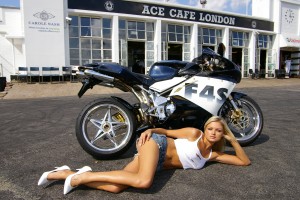
(The final accompanying photo appears courtesy of Crossbow Calendar and the text and photos in the article ‘Taking the High Road’ are ©Vic Barnes)


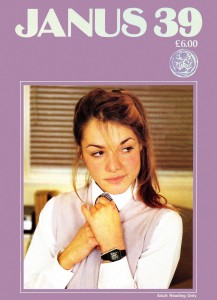
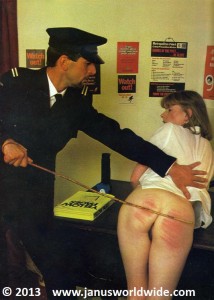
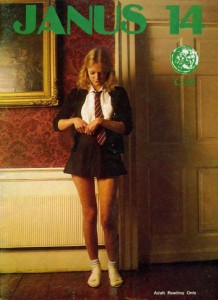
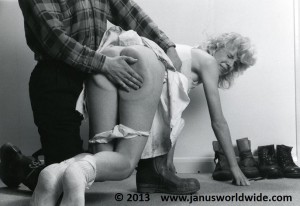
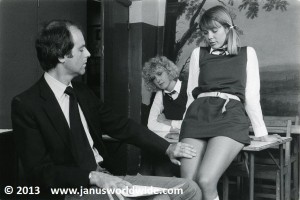
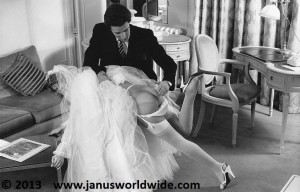
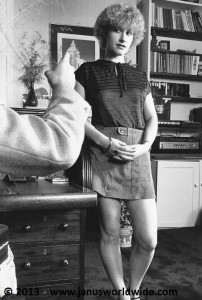
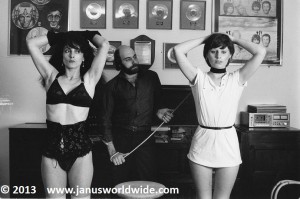
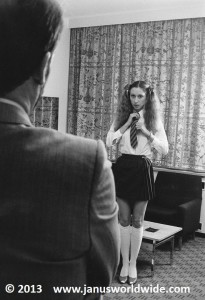
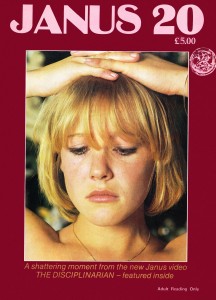
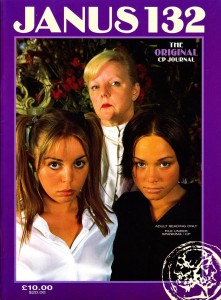
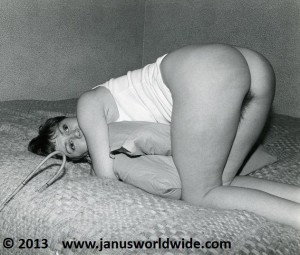
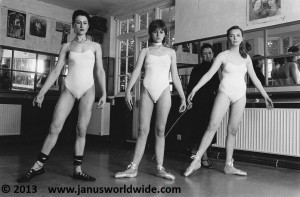
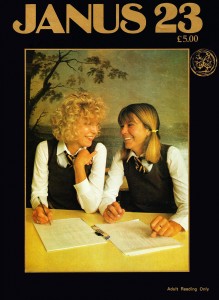
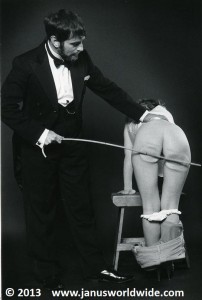
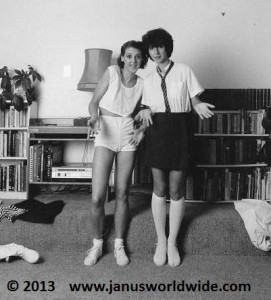
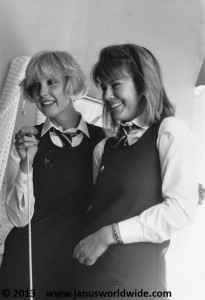
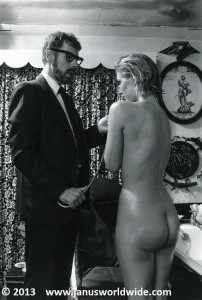
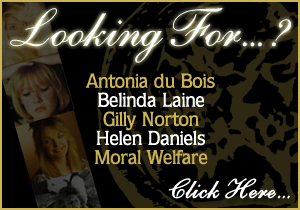
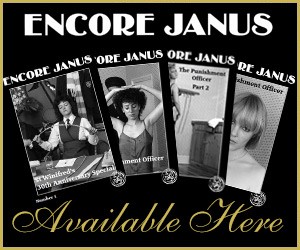

Thanks for publishing this wonderful interview. It provides a fascinating insight into the production side of a magazine that I read avidly at the time. I never had the courage to appear as a model, which was probably for the best all things considered, but I certainy wanted to. Thanks again, and my best wishes to Vic and all of you.
Eleanor
Wonderful interview – thank you Vic!
Great interview. Did anyone else think that idea of a home for elderly spankers was a fantastic one? It would at least be something to look forward to in old age!
best job in the world or what…thanks vic
I was buying Janus long before I should have been but those early photo stories have stayed with me my whole life. It’s nice to be able to put a name to the person who created them and to pass on my thanks.
I really enjoyed this article,it answered a lot of questions that had run through my head many times from years past.
I really admired Vic’s Photography in Janus and being a working Photographer myself ,recognised that Vic was not only a technically very proficient stills Photographer but had such a great eye for my favourite subject!
I could go on at some length ,but will leave it at that,
Many thanks Vic
Fascinating interview and excellent work Vic, I grew up with these wonderful images and still love them decades later. Many thanks to all concerned, Janus is immortal!
Thank you for the beautiful spanking photo’s, you took in Janus Issue 16, of THE WEDDING. There is nothing as beautiful as a naughty bride, being spanked on her bare bottom. Especially when her naked rear end, is encased in suspender-belt and stockings, which enhance that voluptous bare derriere.
Just wanted to add my thanks for publishing this brilliant interview. Reading it took me right back to my youth. Punishment Ballet remains one of my all time favourite photo stories. You are a legend Vic – thank you.
Wow. Thanks John.
Janus was and always will be my favourite publication. This is one terrific interview, thanks for taking the time to do it and post for everyone to read. I often wondered if some of the girls liked to take it or if the marks where added afterwards. Very informative and certainly evoked so many great memories.
Thanks again
BOB
Thank you for this wonderful, in-depth interview.
And thank you Vic for all your great work. Coming of age right before the dawn of the interwebs, Janus was an incredible discovery for me – not only a pleasure in itself but my first validation that I was not alone in my fascination with spanking (which has been a part of me for as long as I’ve been aware of anything).
It’s such a pleasure to hear the story behind your body of work which made such a profound impression on me as a youngster first learning to accept and embracemy sexuality. My hat’s off to you, Sir!
Janus was a great spanky magazine and i was sorry when it finished but it is great to have it here still being spoken about,great interview ,great girls ,best from ,Tim.
thank you for the best cp masturbation material when i was young and still i enjoy reading and relief after